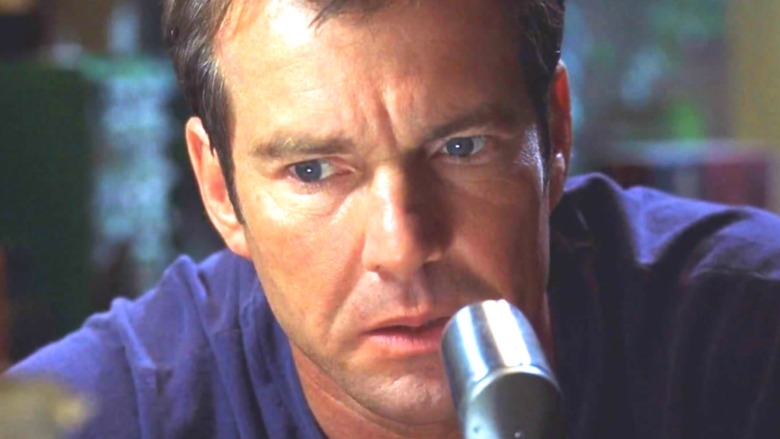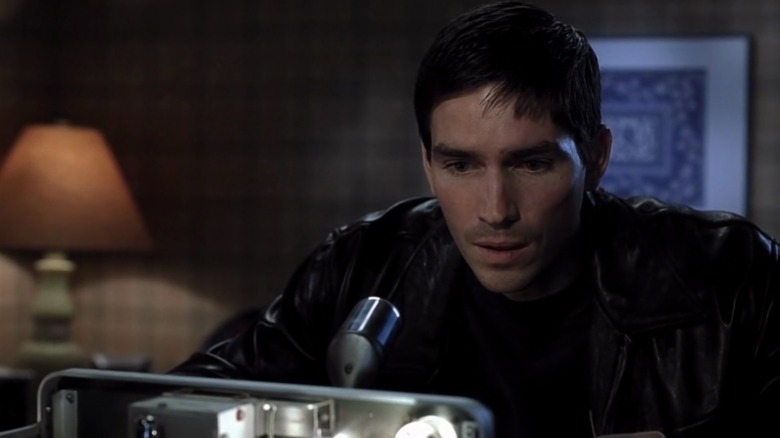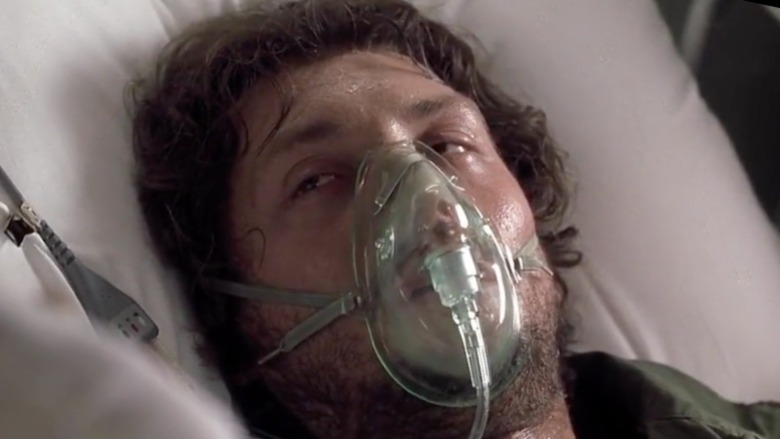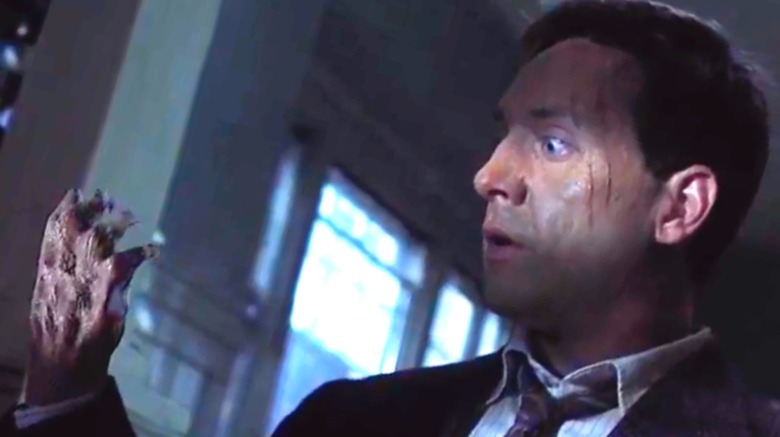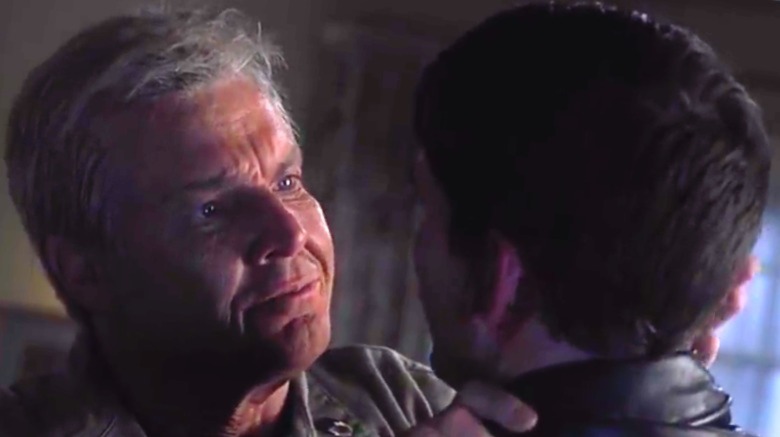The Ending Of Frequency Explained
The 2000 science fiction thriller, "Frequency," tells the story of Frank Sullivan (Dennis Quaid) and his son John (Jim Caviezel) who are able to speak to each other exactly 30 years apart through an old ham radio. The film did fairly well upon release, more than doubling it's $31 million budget at the box office, and there was even a (short-lived) attempt at a 2016 TV series based on the premise.
Now, when it comes to the actual "time radio" that is the catalyst for the entire story, very little information is given. Other than some news reports with buzzwords like "string theory," coupled with the appearance of the Aurora Borealis above Queens, we're mostly given no explanation. Even the main characters state numerous times that they don't understand how this could be possible. So, it's a time radio — just go with it.
However, the plot does outline rules for how the information John gives his father Frank, in the past, impacts his present. Initially, John saves Frank's life by warning him about his death in a fire. The day after his rescue, though, they both face the devastating and unintended consequences of their time manipulation — the murder of John's mother Julia (Elizabeth Mitchell) and several other women by a serial killer.
The movie's basic concept is loosely on the theory of parallel worlds
To understand the movie's ending, let's first look at the time travel rules presented. In effect, the radio very loosely follows the idea of a multiverse, implying that there are infinite parallel versions of our existence happening all at once. The version we're in now is based on the choices we've made, and because time is linear, they can't be changed — unless, of course, you have a time radio.
The movie also goes a step further to create a sort of "temporal bubble" for John, when using the radio, to avoid some obvious paradoxes. For example, if John warns his father about his death and then he survives, he wouldn't know to warn him in the first place, since he never died. To avoid this, John is allowed to keep his memories of every timeline shift he experiences. This bubble also keeps the realities that both John and Frank inhabit connected. For example, if John warns his father and saves his life, it could create a brand new timeline where Frank lives a long and happy existence, but leaves our John in his current reality where his father still dies tragically. As it stands, both John and Frank are linked to the same parallel world every time a shift occurs.
The Nightingale serial killer sets his sights on Julia after she saves his life
The movie also establishes the two ways a person in the past is able to affect the future. First, future realities can shift, based on the moment someone in 1969 makes a revised action. For example, when Frank is at the crossroads of turning left or right in the middle of a burning building, and decides at the last minute to trust his son's advice — that's the moment that an entire new lifetime of memories floods John's mind in the present. Similarly, when his father accidentally sets fire to the table, or cracks the pane in the living room door, you see the charred wood and split glass appear instantly 30 years later.
The second way that time shifts can occur is when those in the past make a revised choice about their future actions.
The clearest example of this is Julia's murder. When Frank comes to visit her at the hospital, it allows Julia to stop a doctor from mistakenly giving a patient a fatal mix of medications. Unfortunately, the patient she saves turns out to be the "Nightingale" serial killer, Jack Shepard (Shawn Doyle). Julia's intervention allows him to kill seven additional women — including her. In that same moment that she saves the "Nightingale," John's reality in 1999 shifts to one where his mother is already dead, even though that event hasn't occurred yet in 1969 — but his new timeline is based on the killer's intended future actions.
The Nightingale enters the temporal bubble
So, with all that information in mind, we come to the climax of the movie, where a younger version of the killer attacks Frank in his home, at the same time that his older version ambushes John in the present. John is unable to warn his father about the attack, since they are happening simultaneously, and he doesn't have any revised memories of the incident yet.
The time radio itself also plays a subtle but crucial role in this battle. Shots heard from 1999 wake up the cuffed and unconscious Frank in 1969 so he can escape. Then the past version of the killer is distracted by the voice of his future-self through the radio, allowing Julia to tackle him and save her son. Additionally, this interaction with the radio puts the killer into the same "temporal bubble" John is occupying. Therefore, when his hand is blown off in 1969 moments later, he is shocked to watch it disintegrate in front of his eyes in 1999. Just like John, he remembers both realities, one in which he was a murderer with both his hands, and now this new timeline, where he's missing an appendage.
Frank Sullivan is revealed to still be alive in the present
The final and most dramatic change is revealed when the entire house in the present transforms its décor, as an older but alive Frank steps into the hall and shoots the killer in the chest. He has survived to 1999 by giving up smoking, but you might wonder — why didn't he appear instantly, once he threw away his cigarettes in the past?
There are two probable reasons. For one, there was a distinct possibility that Frank may not have survived the home invasion. Two, it's likely that his intention to quit became more steadfast after the trauma of almost losing his wife and son.
Now, there are still several inconsistencies dangling in the movie, like how a known, one-handed serial killer is still uncaught 30 years later — or why the future killer would track down John, if he was in hiding. Not to mention, when his hand disappeared, why wasn't there some sort of prosthetic in its place? For that matter, Frank could have had an entire police squad waiting at the ready if he knew Jack was going to be there that day.
However, if our suspension of disbelief can be stretched just a little bit further, we end the movie with a happy family that is able to comfortably grow old together — even if John spends the rest of his life juggling the memories of four distinct lifetimes in his head.
